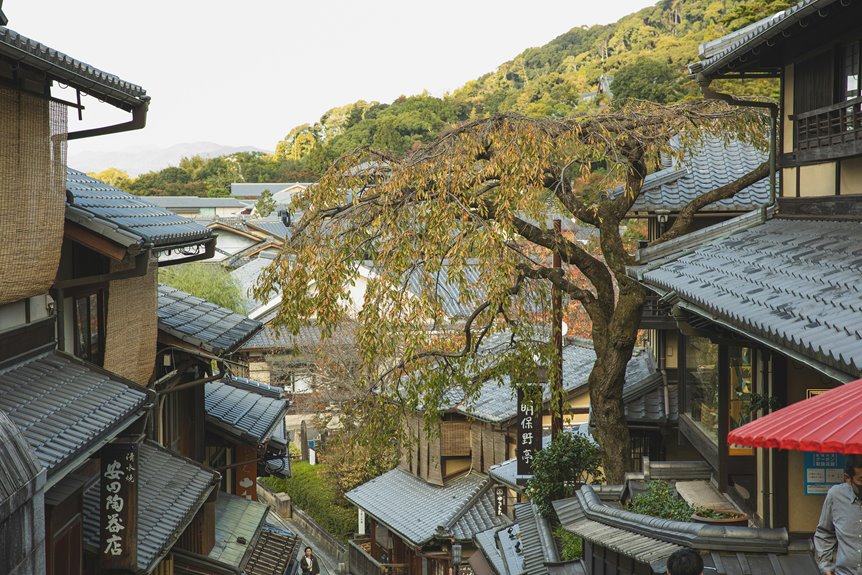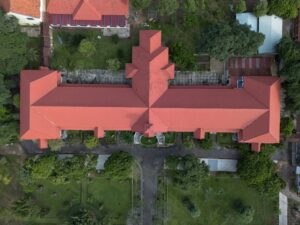Could it be that the preservation of historic roofs is as crucial to maintaining community identity as the buildings themselves? As you explore the role of Synergy Roofing in the Abita Springs Historic District, you'll find a dedicated team that not only restores roofs but also honors the area's rich history. Their use of traditional materials and techniques speaks to a commitment that goes beyond aesthetics. What exactly does this mean for the future of Abita Springs' architectural landscape, and how does it impact the community's heritage?
Key Takeaways
- Synergy Roofing employs historically accurate materials and techniques to preserve the unique architectural heritage of the Abita Springs Historic District.
- The company collaborates with local historians to ensure roofing projects respect and reflect the area's architectural styles.
- By participating in community engagement initiatives, Synergy Roofing raises awareness of the importance of historic preservation among residents.
- Their restoration of notable landmarks, like the Long Branch Hotel, enhances local heritage and promotes tourism in Abita Springs.
- Synergy Roofing's eco-friendly roofing solutions contribute to sustainable practices while maintaining the aesthetic integrity of historic buildings.
Importance of Historic Preservation
Historic preservation plays a vital role in safeguarding the unique architectural heritage of Abita Springs. The Abita Springs Historic District, listed on the National Register of Historic Places since March 12, 1982, encompasses 180 contributing buildings across a 162-acre area. These structures embody various styles, including Colonial Revival, Queen Anne, and Eastlake architecture. By preserving these historic sites, you not only maintain the architectural integrity of the community but also celebrate its early 20th-century residential patterns and leisure activities.
Engaging in historic preservation fosters community identity and pride. When you protect landmarks like the Long Branch Hotel and Abita Pavilion, you're also preserving the stories and memories that define your town. Furthermore, this commitment to preservation can boost the local economy. Tourists attracted to Abita Springs' unique architectural styles contribute to economic sustainability by exploring the area and supporting local businesses.
Ultimately, historic preservation educates both current and future generations about Abita Springs' rich history as a health resort and the significance of its natural springs. By valuing and preserving these sites, you ensure that the essence of Abita Springs remains vibrant for years to come.
Synergy Roofing's Commitment
With a steadfast dedication to preserving the architectural integrity of the Abita Springs Historic District, Synergy Roofing employs historically accurate materials and techniques in every project. By collaborating with local historians, they ensure that each roofing project respects the unique Colonial Revival and Queen Anne styles that define the area. This commitment not only enhances the appearance of iconic structures, like the Abita Springs Hotel, but also aligns with the National Register of Historic Places' guidelines.
Synergy Roofing actively participates in community engagement initiatives, supporting local events that celebrate Abita Springs' rich history and architectural heritage. Their efforts foster a sense of pride among residents, encouraging everyone to appreciate the historic significance of the district.
Moreover, their dedication to sustainability is evident in the eco-friendly roofing solutions they offer, aligning with the preservation goals of the Abita Springs Historic District. By focusing on the ongoing maintenance and restoration of contributing buildings, Synergy Roofing plays a vital role in protecting this area's historical significance for future generations. You can trust that with Synergy Roofing, your commitment to preserving history is in capable hands.
Traditional Roofing Techniques
Emphasizing the importance of tradition, Abita Springs boasts roofing techniques that reflect its rich architectural heritage. In the Historic District, you'll often see roofs adorned with wood shingles or metal, reminiscent of the turn-of-the-20th-century shotgun houses and Colonial Revival buildings. These roofs typically feature steep pitches and overhanging eaves, designed to shed rainwater efficiently and improve ventilation in the humid Louisiana climate.
Preserving historical roofing materials like slate and clay tiles plays a crucial role in maintaining the authenticity of structures listed on the National Register of Historic Places. When you explore the district, you'll notice that roofs are often enhanced by architectural details such as gabled dormers and decorative cornices, showcasing the craftsmanship of their time.
Utilizing historically accurate roofing techniques not only bolsters the aesthetic integrity of Abita Springs but also contributes to the sustainability and longevity of its historic buildings. By embracing these traditional methods, you're not just preserving a home; you're safeguarding a piece of history that embodies the spirit of the community. So, when considering your own roofing choices, remember the significance of maintaining these time-honored traditions.
Impact on Community Heritage
Preserving traditional roofing techniques not only enhances the visual appeal of Abita Springs but also plays a significant role in shaping the community's heritage. By using materials and methods that reflect the turn-of-the-20th century styles, like Colonial Revival and Queen Anne, Synergy Roofing actively contributes to the architectural integrity of the Abita Springs Historic District. This district, with its 180 contributing buildings listed on the National Register of Historic Places since 1982, showcases the unique character and craftsmanship of the area.
When you support these restoration efforts, you're helping to protect the rich cultural history that defines Abita Springs. The roofs of historic structures are more than just functional; they embody the artistry and heritage of the community. Furthermore, Synergy Roofing's commitment to sustainable practices ensures that this unique ambiance is preserved for future generations, fostering a sense of pride among residents.
As a local business, Synergy Roofing engages with the community, raising awareness about the significance of the Historic District. Together, you're not just maintaining roofs; you're safeguarding the essence of Abita Springs' identity and heritage.
Notable Projects in Abita Springs
Highlighting Synergy Roofing's notable projects in Abita Springs reveals a commitment to preserving the district's rich architectural heritage. One of their standout projects is the restoration of the Long Branch Hotel, the first major resort hotel in the area, which proudly holds a spot on the National Register of Historic Places. By utilizing historically accurate materials and techniques, Synergy Roofing ensures that the authentic appearance of turn-of-the-20th-century shotgun houses and other significant structures remains intact.
Their work goes beyond just roofing; it's about celebrating the unique blend of leisure and residential living that defines Abita Springs' historical significance. Every project is a testament to their dedication to craftsmanship, as they collaborate with local preservation societies to respect and maintain the district's aesthetic heritage.
As you explore the Abita Springs Historic District, you'll notice Synergy Roofing's influence in preserving architectural styles like Colonial Revival and Queen Anne. Their efforts mark a significant contribution to the ongoing preservation initiatives, ensuring that future generations can appreciate the beauty and history of this remarkable area. With each completed project, Synergy Roofing reinforces the importance of safeguarding Abita Springs' architectural legacy.
Future of Historic Roofing
As you consider the future of historic roofing in Abita Springs, think about the balance between sustainability and preservation. By incorporating eco-friendly materials and authentic techniques, you can help maintain the unique charm of the district while ensuring durability. Engaging with local experts and understanding historical aesthetics will be key to honoring the town's architectural heritage.
Sustainable Roofing Materials
When it comes to the future of historic roofing in the Abita Springs Historic District, sustainable roofing materials are stepping up to the plate, offering a blend of durability and energy efficiency. These materials not only help preserve the historic integrity of your buildings but also contribute to a greener future.
Consider the following sustainable options:
| Material Type | Benefits | Considerations |
|---|---|---|
| Recycled Metal | Durable and low maintenance | May change aesthetics |
| Eco-Friendly Shingles | Energy-efficient | Variety in styles |
| Slate Tiles | Long-lasting, classic look | Heavier than alternatives |
| Clay Tiles | Natural and eco-friendly | Installation complexity |
| Living Roofs | Enhances insulation | Requires structural support |
Preservation Techniques Explained
Preserving the historic roofing of the Abita Springs Historic District requires a careful blend of traditional techniques and modern approaches. You'll find that effective preservation techniques often involve using materials that closely match the original construction, like slate, wood shingles, or metal. This practice maintains the architectural integrity of the district.
Routine inspections and maintenance are crucial; they help you identify potential issues early, ensuring roofs remain in good condition and prolonging their lifespan. Specialized craftsmanship is essential for historic roofing, as traditional methods are employed to replicate original designs, honoring the Colonial Revival and Queen Anne styles inherent to the district.
Moreover, you can integrate energy-efficient roofing options, such as reflective coatings and insulation, without compromising the historic appearance. This contributes to sustainability while preserving the aesthetic value of these treasured buildings.
Engaging with the community through workshops and educational programs can raise awareness about proper roofing techniques. Such involvement encourages everyone to take part in preserving Abita Springs' unique historical character. By embracing these preservation techniques, you help ensure that this historic district remains a vibrant part of your community's heritage.
Historical Aesthetic Considerations
The rooftops of the Abita Springs Historic District tell a story of architectural evolution, reflecting the Colonial Revival and Queen Anne styles that define the area. When considering roofing options, you'll want to prioritize historical integrity. This means using materials that align with the original structures, like wood shingles or slate, to preserve that turn-of-the-20th-century aesthetic.
Local regulations often require that any roofing renovations comply with the guidelines set forth by the National Register of Historic Places. This ensures that the cultural significance of the district remains intact. While it's essential to stay true to traditional styles, you can also integrate modern roofing technologies. Energy-efficient materials that mimic historical designs can enhance the longevity and sustainability of your home without compromising its appearance.
Engaging with the community and educating others about the significance of preserving these historical roofing practices can foster a deeper appreciation for Abita Springs' architectural heritage. By promoting responsible restoration efforts, you'll not only contribute to the beauty of the district but also help ensure that its story continues for generations to come.
Frequently Asked Questions
What Is the History of Abita Springs?
You're stepping into the charming embrace of Abita Springs, a town steeped in rich history. Originally a healing haven for the Choctaw tribe, it transformed in the 1830s with European settlers. By the late 19th century, local landmarks like the Long Branch Hotel welcomed visitors seeking respite from New Orleans' heat. The arrival of the railroad further boosted tourism, solidifying Abita Springs' reputation as a delightful retreat, even as its resort days gently faded.
Are There Springs in Abita Springs?
Yes, there are springs in Abita Springs! Historically, these springs were celebrated for their water quality and medicinal benefits, attracting visitors seeking wellness. Though they're no longer commercial attractions, their legacy endures in the town's identity. You can appreciate the rich history and natural beauty of the area while exploring its charming surroundings. The springs may not be bustling with activity now, but their significance remains an essential part of Abita Springs.




